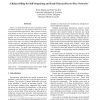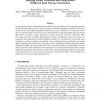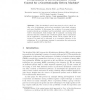96 search results - page 6 / 20 » On the Duality of Fault Tolerant System Structures |
WORDS
2003
IEEE
14 years 22 days ago
2003
IEEE
This paper discusses some of the typical characteristics of modern Web applications and analyses some of the problems the developers of such systems have to face. One of such type...
SCCC
2007
IEEE
14 years 1 months ago
2007
IEEE
There is no doubt about the increase in popularity of decentralised systems over the classical client-server architecture in distributed applications. These systems are developed ...
DFT
2009
IEEE
14 years 2 months ago
2009
IEEE
Pre-fabrication design verification and post-fabrication chip testing are two important stages in the product realization process. These two stages consume a large part of resourc...
ECAL
2005
Springer
14 years 1 months ago
2005
Springer
Using decentralized control structures for robot control can offer a lot of advantages, such as less complexity, better fault tolerance and more flexibility. In this paper the ev...
COOPIS
2002
IEEE
14 years 13 days ago
2002
IEEE
Abstract. The CORBA standard now incorporates support for reliability through two distinct mechanisms — replication (using the Fault Tolerant CORBA standard) and transactions (us...



